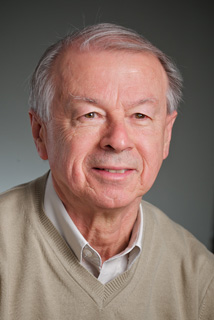Josef Takats
|
Professor Emeritus
|
|
We are involved in the synthesis and chemistry of organometallic compounds of the transition metals and f-elements. Within this vast field current research is focused on two specific areas.
In the area of organotransition metal chemistry we continue to capitalize on our discovery that the alkyne ligand in M(CO)4(η2-alkyne) (M = Ru (1b), Os (1c)) compounds imparts remarkable reactivity compared to the parent pentacarbonyls. We have successfully extended the work to the analogous Fe(CO)4(η2-alkyne) (1a) compounds and demonstrated that, as has been postulated some 40 years ago, they are indeed intermediates in the iron carbonyl mediated coupling of alkynes and carbon monoxide. In collaboration with Professor R.B. Jordan of this department it was established that the rate of CO dissociation in 1a is some 13 orders of magnitude faster than in Fe(CO)5. A recent success is the isolation of Fe(CO)2(PR3)(η2-HFB), the putative intermediate in the substitution reactions. A surprising feature of these compounds is their ability to react with other 18-electron species to generate dimetallacyclic complexes; the chemistry of Fe(CO)4(η2-alkyne) is especially rich in diversity. Work is continuing to unravel the mechanisms of these fascinating reactions and to extend the series of dimetallic complexes to include early transition metals as well.

Steric fine-tuning is the strategy used in our construction of low coordinate f-element complexes. The ligands of choice are the hydrotris(pyrazolyl)borates, HB(3-R,5-R'-pz)3 or TpR,R', whose size can be conveniently altered by judicious choice of the substituents on the pyrazol ring. We have shown that Sm(TpMe2)2 is an excellent agent to trap anionic radical species and allowed the isolation of the first lanthanide superoxo complex. Current work is directed to the synthesis of ligand-bridged heterobimetallic complexes (cf. (TpMe2)2Sm(µ-O2)MLn) and to the study of electronic communication and magnetic exchange between the redox active metal centers. The synthesis of rare mono-ligand (TpMe2)UX2 and (TptBu,Me)LnX (Ln = Sm, Yb) complexes has been accomplished, including the first discrete Ln(II) hydride [(TptBu,Me)YbH]2; the derivative chemistry and potential application of the compounds in catalysis are the focus of current research efforts.

Molecular structure of a discrete Ln(II) hydride, [(TptBu,Me)Yb(µ-H)]2
Selected Publications
G.M. Ferrence and J. Takats, "[(Tpt-Bu,Me)Yb(μ-H)]2: a fecund precursor to a host of divalent, hydrotris(pyrazolyl)borate supported f-element complexes", J. Organometal. Chem. 2002, 647, 84-93.
N. Marques, A. Sella and J. Takats, "Chemistry of the Lanthanides Using Pyrazolylborate Ligands", Chem. Rev. 2002, 102, 2137-2159.
D.R. Muhandiram, G.-Y. Kiel, G.H.M. Aarts, I.M. Saez, J.G.A. Reuvers, D.M. Heinekey, W.A.G. Graham, J. Takats, R.E.D. McClung, "Multisite Magnetization Transfer Studies of Metal Migration in (η3-C7H7)Re(CO)4, (η3-C7H7)Os(CO)3SnPh3, (η3-C7H7)Re(CO)3(PMe3), (η5-C7H7)Re(CO)3, (η5-C7H7)Fe(CO)2SnPh3, (η5-C7H7)Os(CO)2SnPH3, and (η5- C7H7)Ru(CO)2SnPh3", Organometallics 2002, 21, 2687-2704.
G.M. Ferrence, R. McDonald, M. Morissette and J. Takats, "Mixed Pyrazolylborate/Cyclopentadienyl Derivatives of Divalent Lanthanides: Synthesis and Structure of (Tpt-Bu,Me)Yb(C5H4R) (R = H, SiMe3)", J. Organometal. Chem. 2000, 596, 95-102.
G.Y. Kiel, Z.S. Zhang, J. Takats and R.B. Jordan, "Dimetallacycles from Monomeric 18-electron M(CO)4(η2-C2H2) and M(CO)5 (M = Ru, Os) Building Blocks; Synthesis and Mechanism of Formation", Organometallics 2000, 19, 2766-2776.
